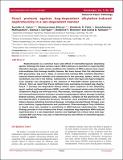Parp1 protects against Aag-dependent alkylation-induced nephrotoxicity in a sex-dependent manner
Author(s)
Bronson, Roderick T.; Calvo, Jennifer; Allocca, Mariacarmela; Fake, Kimberly; Muthupalani, Sureshkumar; Corrigan, Joshua; Samson, Leona D; ... Show more Show less
DownloadCalvo-2016-Parp1 protects again.pdf (9.811Mb)
PUBLISHER_CC
Publisher with Creative Commons License
Creative Commons Attribution
Terms of use
Metadata
Show full item recordAbstract
ephrotoxicity is a common toxic side-effect of chemotherapeutic alkylating agents. Although the base excision repair (BER) pathway is essential in repairing DNA alkylation damage, under certain conditions the initiation of BER produces toxic repair intermediates that damage healthy tissues. We have shown that the alkyladenine DNA glycosylase, Aag (a.k.a. Mpg), an enzyme that initiates BER, mediates alkylation-induced whole-animal lethality and cytotoxicity in the pancreas, spleen, retina, and cerebellum, but not in the kidney. Cytotoxicity in both wild-type and Aag-transgenic mice (AagTg) was abrogated in the absence of Poly(ADP-ribose) polymerase-1 (Parp1). Here we report that Parp1-deficient mice expressing increased Aag (AagTg/Parp1-/-) develop sex-dependent kidney failure upon exposure to the alkylating agent, methyl methanesulfonate (MMS), and suffer increased whole-animal lethality compared to AagTg and wild-type mice. Macroscopic, histological, electron microscopic and immunohistochemical analyses revealed morphological kidney damage including dilated tubules, proteinaceous casts, vacuolation, collapse of the glomerular tuft, and deterioration of podocyte structure. Moreover, mice exhibited clinical signs of kidney disease indicating functional damage, including elevated blood nitrogen urea and creatinine, hypoproteinemia and proteinuria. Pharmacological Parp inhibition in AagTg mice also resulted in sensitivity to MMS-induced nephrotoxicity. These findings provide in vivo evidence that Parp1 modulates Aag-dependent MMS-induced nephrotoxicity in a sex-dependent manner and highlight the critical roles that Aag-initiated BER and Parp1 may play in determining the side-effects of chemotherapeutic alkylating agents.
Date issued
2016-07Department
Massachusetts Institute of Technology. Center for Environmental Health Sciences; Massachusetts Institute of Technology. Department of Biological Engineering; Massachusetts Institute of Technology. Division of Comparative MedicineJournal
Oncotarget
Publisher
Impact Journals/National Center for Biotechnology Information (U.S.)
Citation
Calvo, Jennifer A.; Allocca, Mariacarmela; Fake, Kimberly R.; Muthupalani, Sureshkumar; Corrigan, Joshua J.; Bronson, Roderick T. and Samson, Leona D. “Parp1 Protects Against Aag-Dependent Alkylation-Induced Nephrotoxicity in a Sex-Dependent Manner.” Oncotarget 7, no. 29(July 2016) © Impact Journals/National Center for Biotechnology Information (U.S.)
Version: Final published version
ISSN
1949-2553